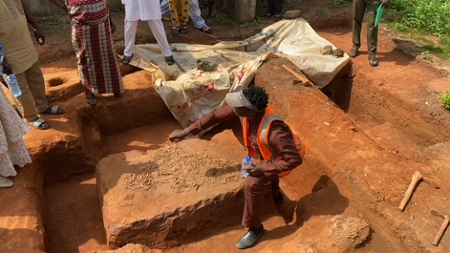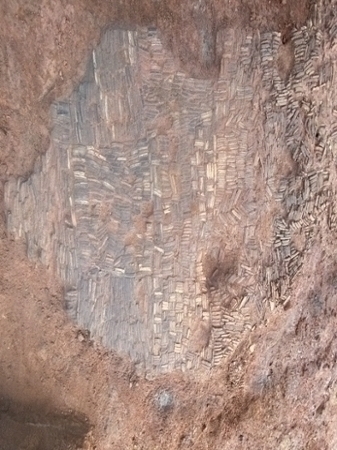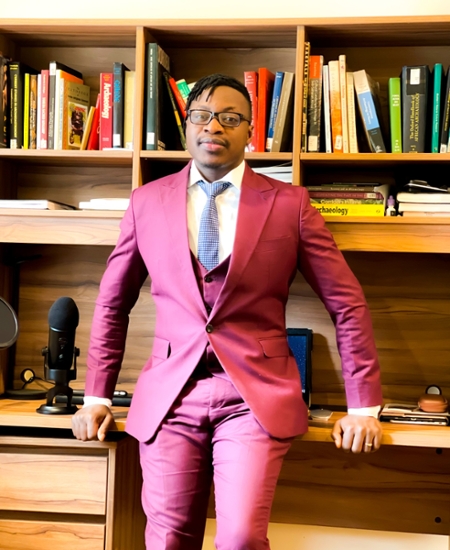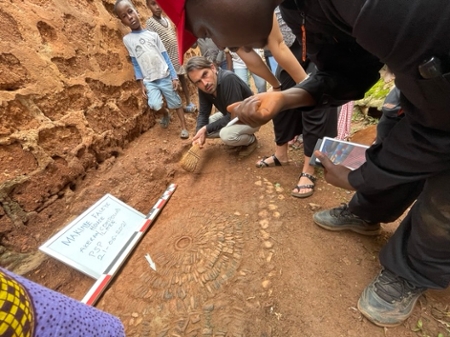February 2022 Feature: Olanrewaju Blessing Lasisi
1. How did you become interested in anthropology and archaeology?
My interest in the discipline started when I was in high school, in Nigeria. My teacher mentioned Homo-sapiens in a social studies class. I needed clarifications on the origin of the word so I asked the teacher. She told me, cavalierly, "Look, I am not an archaeologist." Even though I now know that she meant "paleoanthropologist," I was struck with much curiosity as to who archaeologists are, and what they do. When I graduated from high school, I had to save up money to defray the costs of going to the University of Ibadan. At this time, I had read so much about archaeology and just needed to do menial jobs to pay my undergraduate fees. I went to my hometown to work as a laborer at a construction site. While mixing sand and cement, I churned up the topsoil. There I found about ten potsherds, and I asked, "who used and made them?" Since then, it felt right that I should pursue being an archaeologist to answer the question, "who used and made them?"
2. What is your main research focus? How has your time at W&M enabled you to pursue these interests?
My research examines the practice of space and power in the Ijebu kingdom, southwestern Nigeria. I argue that Architecture, Ritual, and Astronomy lies at the core of Ijebu's socio-political, economic, and cultural organizations.
William & Mary challenged me to think creatively and to design my project in a challenging manner. When I arrived in 2016, I had a clue of where I would carry out my research, but I was not theoretically grounded. My exposure to archaeological and anthropology theory classes with Dr. Audrey and Dr. Bragdon, respectively, showed me how I can help to create a localized model of urbanism that can be tested in a Yoruba community of practice context. This allowed me to see Yoruba palace complexes as landscapes of power, performing political, religious, and commercial functions all of which cannot exist without what I refer to as power ensemble. Power ensemble is the power structure created by Architecture, Ritual, and Astronomy on the landscape of power. It was with the guidance of my advisor and committee members (Dr. Norman, Dr. Chouin, Dr. Gundaker, and Dr. Ogundiran-external) that I am able to frame my research in a way that it would not only fill a lacuna in scholarship but will transform the ways we interpret and contextualize African material cultures that had previously been seen differently in African archaeology.
My research at William & Mary would also not have been made possible without the support of other Anthropology faculty members, the Reves Center, and the Dean of Art & Science. For example, I feel honored to have worked with Dr. Blakey at the Institute of Historical Biology and Dr. Kostro at the Colonial Williamsburg Foundation. I have also received internal financial support from the Anthropology Department, Ife-Sungbo Archaeology Project (Dr. Chouin & Dr. Norman), School of Art and Science, and Reves center.
3. Do you have a favorite project or artifact you have worked with?
My favorite artifacts are the ceramic pavements discovered during the most recent excavations for my doctoral research. Pavements are formed by arranging potsherds or stone pebbles in the form of tiles and pinned to the ground. Pavements have been found to be used as house floors or as any other architectural aesthetics. The pavements found in my research on the landscape of power help to understand that they also functioned as arts (carved as an effigy), sundials (astronomically aligned, and accurately functioning as a ritual calendar), and mnemonic devices (has ritual movement maps marked on it). This discovery will allow scholars to discuss indigenous map-making and archaeoastronomy in understudied regions where pavements have been found.


4. What are your plans for when you finish your PhD in terms of potential job placements?
My plan is to take up a Post-Doctoral and/or Assistant Professor position. A short-term goal would be to turn my dissertation into a book, start a second book project, and on a long-term basis, to continue my research on ancient civilizations through archaeology and its sub-discipline, archaeoastronomy.


5. What advice would you give new graduate students in terms of being successful in their careers?
There will be ups and downs, but refuse to waver. Sometimes, it might look as though there is no progress made, refuse to give in or give up. You might feel as though the pressure is much, remain focused. Lastly, do not be afraid to apply for the most prestigious awards because those who get them are people like you... In any way, do not let financial remuneration be your driving force. Let your passion for research and scholarship drive you beyond the stars.
 Skip to main content
Skip to main content
